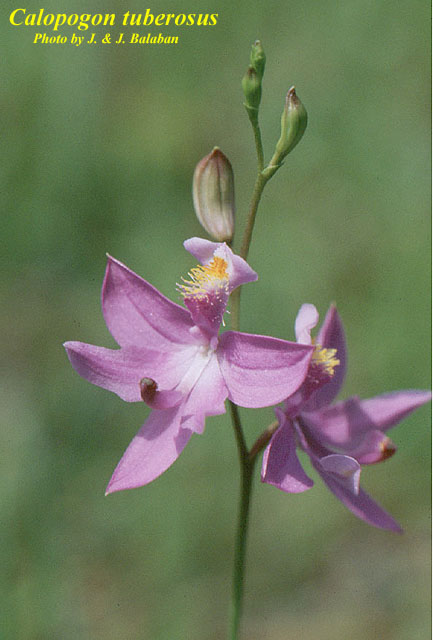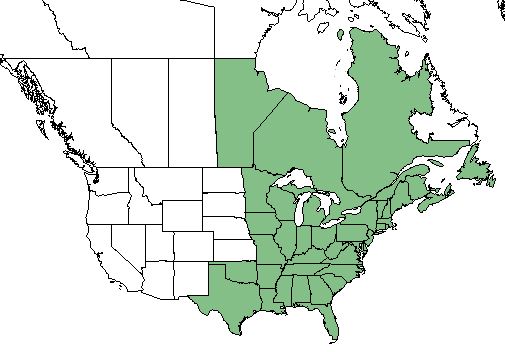Calopogon tuberosus
Common Names: Tuberosus Grasspink[1]; Grass Pink Orchid[2]; Common Grass-pink[3]
| Calopogon tuberosus | |
|---|---|

| |
| Photo by the Atlas of Florida Plants Database | |
| Scientific classification | |
| Kingdom: | Plantae |
| Division: | Magnoliophyta - Flowering plants |
| Class: | Liliopsida - Moncots |
| Order: | Orchidales |
| Family: | Orchidaceae |
| Genus: | Calopogon |
| Species: | C. tuberosus |
| Binomial name | |
| Calopogon tuberosus L | |

| |
| Natural range of Calopogon tuberosus from USDA NRCS Plants Database. | |
Contents
Taxonomic Notes
The genus Calopogon is derived from the Greek words meaning beautiful beard.[4]
Synonyms: Calopogon pulchellus R. Brown; Limodorum tuberosum Linnaeus.[5]
Varieties: Calopogon tuberosus (Linnaeus) Britton, Sterns, & Poggenburg var. tuberosus.[5]
Description
C. tuberosus is a perennial forb/herb in the Orchidaceae family native to North America.[1] The prominent hairs, called the Beard, on the lip of the petal as well as the sweet fragrance from the flower are the main identifying features.[4] The plant originates from a small ovoid corm that has many fibrous roots. It has 1 to rarely 2 basal grass-like leaves that are linear and ribbed. Flowers on a loose terminal raceme between 1 - 8 blossoms, the buds are sickle-shaped, and the bracts are ovate-lanceolate and acuminate in shape. The flowers are a deep magenta or rose-purple color, and the middle petal is oblong-elliptic and acute. The lip is uppermost, linear, and dilate into rounded or triangular apex.[6] Average maximum root depth is 7 cm with 23.1% root porosity.[7]
Distribution
Found along the east coast of the United States and Canada into the center of North America, the C. tuberosus is common in savannas, sandhill seeps, and in bogs within mountain regions.[3]
Calopogon tuberosus var. simpsonii is endemic to subtropical Florida from Lake Okeechobee southward, and can be found in the Bahamas and western Cuba.[8]
Ecology
Habitat
C. tuberosus is common in savannas, sandhill seeps, floating peat mats, and other regions during April to September. [3] A variety of other habitats that this orchid can been found include, marl prairies, pine flatwoods, roadsides, fens, and bogs. [9] Specimens of C. tuberosus have been collected from moist loamy sand of savanna like longleaf pine regions, and wet seepage areas. [10]
Associated species: Arnoglossum sp., Lycopodiella sp., Rhynchospora sp., Juncus sp., Utricularia sp., Cliftonia monophylla, Sarracenia leucophylla, Syngonanthus flavidulus, Eriocaulon compressum, Lachnocaulon anceps, Drosera capillaris, Drosera tracyi, Xyris torta, Solidago patula, Chasmanthium laxum, Pyrus arbutifolia, and Rhododendron canescens.[10][11]
Phenology
Common bloom time is between March and August.[4] It has been observed to flower in the southeast coastal plain from April to June with peak inflorescence in April.[12]
Seed bank and germination
Generally, warmer temperatures produce more seedling germination for the C. tuberosus with the exception of Michigan where cooler temperatures resulted in more germination. Also, fluctuating temperatures are more beneficial than stagnant temperatures. [13]
Fire ecology
C. tuberosus has been observed in previously burned sites and burned wet pinelands.[10]
Pollination
C. tuberosus does not provide a benefit to pollinators, due to this aspect they use deceit to get pollinators to come. Bees land on fake stamens which causes the structure to collapse and transfer pollen to the bee.[14] With this, it has been shown for bumblebees to avoid these flowers after sampling it in search for flowers that do offer rewards.[15]
Conservation, cultivation, and restoration
C. tuberosus is listed as endangered by the Illinois Department of Natural Resources, the Kentucky State Nature Preserves Commission, and the Maryland Department of Natural Resources. It is also listed as a species of special concern by the Rhode Island Department of Environmental Management, and listed as exploitably vulnerable by the New York Division of Land and Forests.[1]
Cultural use
Photo Gallery
References and notes
- ↑ 1.0 1.1 1.2 USDA Plant Database
- ↑ Board, I. E. S. P. (2015). "CHECKLIST OF ILLINOIS ENDANGERED AND THREATENED ANIMALS AND PLANTS." Illinois List of Endangered and Threatened Species: 1-16.
- ↑ 3.0 3.1 3.2 Weakley, A. S. (2015). Flora of the Southern and Mid-Atlantic States. Chapel Hill, NC, University of North Carolina Herbarium.
- ↑ 4.0 4.1 4.2 [[1]] Lady Bird Johnson Wildflower Center. Accessed: March 29, 2019
- ↑ 5.0 5.1 Weakley, A.S. 2015. Flora of the southern and mid-atlantic states. Working Draft of 21 May 2015. University of North Carolina at Chapel Hill, Chapel Hill, North Carolina.
- ↑ Brackley, F. E. (1985). "The Orchids of New Hampshire." Rhodora 87(849): 1-117.
- ↑ Brewer, J. S., et al. (2011). "Carnivory in plants as a beneficial trait in wetlands." Aquatic Botany 94: 62-70.
- ↑ Sorrie, B. A. and A. S. Weakley 2001. Coastal Plain valcular plant endemics: Phytogeographic patterns. Castanea 66: 50-82.
- ↑ Kauth, P. J., et al. (2011). "Comparative in vitro germination ecology of Calopogon tuberosus var. tuberosus (Orchidaceae) across its geographic range." The Society for In Vitro Biology: 148-156.
- ↑ 10.0 10.1 10.2 Florida State University Robert K. Godfrey Herbarium database. URL: http://herbarium.bio.fsu.edu. Last accessed: March 2019. Collectors: Loran C. Anderson, Robert K. Godfrey, R. Komarek, R. A. Norris, and Rodie White. States and Counties: Florida: Franklin, Jackson, Leon, Liberty, Taylor, and Wakulla. Georgia: Grady and Thomas.
- ↑ Morris, M. W. (1989). "Noteworthy vascular plants from Grenada county, Mississippi." SIDA, Contributions to Botany 13(2):177-186.
- ↑ Nelson, G. PanFlora: Plant data for the eastern United States with emphasis on the Southeastern Coastal Plains, Florida, and the Florida Panhandle. www.gilnelson.com/PanFlora/ Accessed: 29 MAR 2019
- ↑ Kauth, P. J., et al. (2011). "Comparative in vitro germination ecology of Calopogon tuberosus var. tuberosus (Orchidaceae) across its geographic range." The Society for In Vitro Biology: 148-156.
- ↑ Explained by Roger Hammer, May 2018, posted to Florida Flora and Ecosystematics Facebook Group May 20, 2018.
- ↑ Davis, R. W. (1986). "The pollination biology of Cypripedium acaule (Orchidaceae)." Rhodora 88: 445-450.